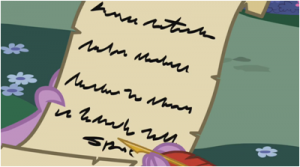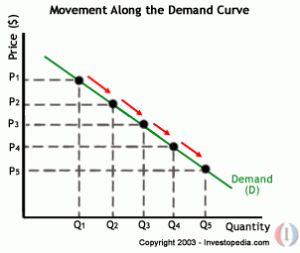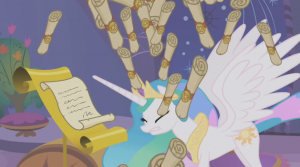Posts Tagged "Indiegogo"
How To Do a Kickstarter: Perks
So Kickstarter uses a concept called “Price Discrimination” which allows you to reach different markets simultaneously and increase your profits by including people who won’t pay as much. It’s the same logic as the Playstation “Greatest Hits,” you sell the same game for cheaper after you’ve already sold to all the people who were willing to pay $50 for a $20 game.
But selling in tiers is a little different from just selling a product and later changing your prices. So here’s some advice on how to sell to these markets and maximize profits.
Low Tiers
Pocket change adds up. So do costs. The key to keeping your profits in the lower tiers is to offer something of value while keeping your hard costs (materials, manufacturing, and shipping) down.
Offer something that can be delivered digitally: File downloads, links to hidden behind the scenes Youtube videos, digital drawings, etc. This will keep your hard costs down.
Offer something that costs little and ships for cheap: Autographed photo, drawing, etc.
Thank You Tiers
A Thank You Tier is a tier where the donor gets nothing but a “Thank you.” Most projects have one. I think this is a lack of imagination (see options above) and a leak of potential money.

“No pony wants to buy a THANK YOU! Your appreciation should be an expected part of any transaction! People want to help you, but they don’t want to just waste their money! If you want to penetrate the nickle and dime markets you had better come up with a clever way to actually GIVE A PONY SOMETHING FOR THEIR MONEY AND DO IT FOR FREE!”
As of this writing the Connu campaign is only half-way done and due to the digital nature of their project, they can offer real incentives to their lower tiers without adding to their hard costs. In the $10 and under tiers they’ve earned $553. If this momentum keeps up they will likely fill 10% of their quota with the nickle and dime tiers.
Another campaign I’ve followed was an Indiegogo campaign was for a short film called “Shadow.” This campaign followed so many of my smaller rules and had great business strategy! At the same time there were many oversights that left much to be desired, or even felt insulting to the contributor. For instance they had 2 thank you tiers ($2 and $10), but they will only thank someone on their website if they give $10. How stingy! And what does that say to the $2 contributors? It says that even though they say “thank you” that they don’t appreciate it! It’s no surprise that Shadow only made $62 in the lower tiers, which is less than 1% of their quota.
Middle Tiers
Selling to the middle tiers is usually about value. Is the price reasonable? Is this a value or a good use of my money? Is this rare? Is this special?
You’ll find greater success with the middle tiers if you really show why your project is special and if this is where you’re simply selling your project: Bluray of the movie, copy of the game, CD of the album, etc.
If you have a monopoly on your product and you can generate enough interest in it (why you should invest in your video), then you can safely inflate the price of your wares.
Note: Being too greedy will cost you
Law of Demand states that goods have a price which will yield the greatest profit. If you price something too high, you will sell too little (which hurts profits). If you price something too low, you will sell much more, but you still won’t make much of a profit. The key is to try to find the right value (P3 and Q3 in the chart above). The Law of Demand is sometimes called the “Law of the Bloody Obvious,” probably a British term.
Thus fair pricing will actually increase your profits. You should do a survey of your friends (unless your friends are rich, then ask other people…or actually you should just ask your rich friends for money) to find a good prices. Keep in mind that what people will pay for say “The Brony Documentary” might not be the same as what they’d pay for “indie short film about failed marriage.”
Top Tiers
The top tier donors are usually people who have too much income and want to be apart of something. Money is not particularly a problem with these people. Usually what most Kickstarters do is find a way to either give these donors super rare things, such as evenings with celebrities or autographed rare merchandise or they find some way to include the donor into the creation of the project itself: an NPC (non person character), an extra in the background of your film or comic, etc.
The Shadow campaign had a great strategy for the top tiers: sell to businesses. They offered walk on roles or product placement and advertisements in the film. It’s impossible to tell whether anyone bought this from them or whether they elected to be an extra in the film, so I’ll say they earned 0-10% of their funding this way. Either way it’s a really good idea. If someone won’t spend their own money, they might spend their business’ money.
Tier to Tier Sales
So each tier adds something new to the perks below it for an added cost. Many crowd sourced projects leak money by not making the cost increase equal to what is added. So many of their donors choose a lower tier than they normally would. Now it’s impossible to accurately guess opportunity costs, but I’m going to speculate a little.
The Indiegogo campaign for the unreleased tapes of the Brony Documentary had 227 people donate $10, but only 29 people donate $25. This is a huge drop off from
These were their perks.
$10
-Digital download of film
-Photo album access$25
-Sticker sheet
Essentially you’re paying $15 for a sheet of stickers. These stickers cost more than the actual video file. I wonder how many people donated $10 instead of $25 because they couldn’t justify spending $15 on stickers.
I believe the following would have generated more money for them, simply by adding more value to the added investment.
$10
-Digital download of film$25
-Sticker sheet
-Photo album access
$10 tier just gives the bronies what they want, to see the added footage. $25 gives you the stickers and exclusive access to photos.
That’s it for perks advice! Good luck!
More:
How To Do a Kickstarter: Sharif Acts Like Don Draper on an E-Mail (Public Relations)
How To Do a Kickstarter: Perks
How To Do a Kickstarter: E-Mails
How To Do a Kickstarter (Short Version)
How To Do a Kickstarter: E-Mails
Skullgirls has probably done one of the most successful campaigns ever. Their initial goal was $150,000, but they ended up earning close to a million dollars. If you look back at the How To Do a Kickstarter (Short Version), and compare it with how Skullgirls did their campaign, you can see what they’ve done right.
One really important thing that I forgot to mention in the short list (might go back and add it) is INVOLVE YOUR DONORS IN THE PROJECT! Skullgirls created surveys and everyone who donated any amount of money got some say in who the new downloadable character would be. This is how they got me to donate. I paid $1 so that I could vote for Marie, a character voiced by Rina-Chan. By the way I should note, I DON’T EVEN PLAY SKULLGIRLS!
This brings me to the greatest benefits and faults of their campaign, E-mails.
Do’s
1. Keep your donors updated
Use the e-mail feature of Kickstarter to keep your donors informed about what their money is doing. People work hard for their money. They want to know what they helped to create with it. This will make them more inclined to contribute to future projects or spread word of mouth on this one. Dale Carnegie said, “People support a world they help to create.” And boy, let me tell you, Skullgirls kept the donors updated…maybe too much. More on that in the “don’ts” section.

Dear Jerks,
Today I used your funds to buy a burrito. It was delicious. You guys are such saps.
-Spike (Bad example. Good idea.)
2. Involve your donors
Skullgirls gave all donors a chance to vote on the new downloadable character. They used the e-mails to send out links to surveys which allowed the donors a chance to take a real role in the development of the game. Based upon how much additional funding they’ve received, I believe this alone could easily be responsible for over $100,000 of their contributions.
3. Rally the troops
People have given you money, because you’re their friend and they don’t want to hear you bitch about how you didn’t support them they believe in what you want to do. Sending out mid-campaign e-mails to remind people the clock is ticking and that they can help by sharing your campaign with their friends is a good way to make money. Don’t just crowd source your funds, crowd source your fund gathering. With Rina-Chan’s participation, quite a few bronies championed the funding of Skullgirls. At least I know Spenser from the Brony Clubhouse was shouting from the social media heavens about it.
4. Sell to the lower tiers
So your creative team is paid, your work is done, and the final product is hitting stores. Now what? Well, not everyone bought your work. The lowest tiers probably gave you a dollar for basically nothing in return. They’re clearly a hot lead for someone who likes the project. E-mail them and let them know that your movie/game/hot dogs are now for sale.

“I know you didn’t give me enough money to actually get a ‘free’ bus playset, but it’s now available in stores for you to purchase with additional money.” (Image Source Dawn Somewhere)
Maybes?
1. Numbered only for uniformity but this is the only maybe. It’s a good idea to use this e-mail list serve to promote future projects.
This is a good idea, because these people are already interested in what you do and are hot leads for your next project. IT IS A BAD IDEA TO JUST START E-MAILING PEOPLE! The right way to do this is to e-mail your donors (burying the lead) thanking them, and then asking if they would like to sign up for a mailing list about your future projects.
Trust me, you don’t want to e-mail people directly about your other projects (see the first don’t). Best case scenario people unsubscribe. Worst case scenario, they flag you as spam and your e-mail will get shot down by spam blockers. It’s in your best interest to ask them to subscribe to your personal newsletter (Bonus tip: You’ll get more people if you reassure them that they can unsubscribe! Also make a method for them to unsubscribe.)
If you’re so daring, don’t be a selfish tool when doing this. Keep in mind that your work may have brought publicity for the stars of your project. Your donors may want to follow the artists or actors on Twitter or Facebook. Spread the love, because those stars probably promoted your Kickstarter.
Don’ts
1. Don’t spam!
Do not send people info about other people’s projects or the projects of your friends. Try to keep everything relevant and on topic to what people signed up for (I know this kinda contradicts the advice immediately above this).
2. Don’t overwhelm your donors.
This is the one thing I hated with the Skullgirls campaign. They e-mailed me ALL THE TIME. Limit e-mails to a MAXIMUM of 2 a week.
3. Most importantly, don’t make it all about yourself or your project.
Your donors have just made it possible for you to fulfill a dream. They may do it, because they love you. But they can also be motivated by their desire to be a part of something important. It is never a bad idea to make someone feel special. Look through your e-mail and see how many times you say “I” or “We” versus how many times you say “you.” Remember even though this is about you, make it about them. They gave you money, it’s the least you could do…other than the perks they bought.
More:
How To Do a Kickstarter: Sharif Acts Like Don Draper on an E-Mail (Public Relations)
How To Do a Kickstarter: Perks
How To Do a Kickstarter: E-Mails
How To Do a Kickstarter (Short Version)
How To Do a Kickstarter (Short Version)
I hate most crowdfunding. It’s not really that I have a problem with the concept, but most people irritate me with they way they ask for my money. It’s like you’re asking ME for money so that you can start a business in which you keep making money, and I get an overpriced ______. So you should at least try to seduce me a little and not just be a bunch of annoying, entitled 20 something year olds. Show me that you care. Show me this is real. Show me that I’m not just a sucker and a means to an end. Make me feel like I’m a part of something special, not just something special to you, but to me and the rest of the world.

“Here, I’m giving you 2 bits for your project. Please don’t hate me. I’d give you more, but Wells Fargo lent me that money so I can go to school.” -Me every time I donate to a friend
How do you do that? Here are some Cliff Notes that should help. Later I’ll do a more expanded post focusing on the videos, perks, & e-mails.
Image
1. Look like you’re serious (If your project is fun, show that you’re serious about fun).
2. Look like you’ve actually put some of your own money into this project (at least INVEST IN YOUR VIDEO!)
3. Look like you would actually invest in this project yourself.
4. Look like you aren’t just asking someone to pay the rent and buy you Taco Bell while you make art.
Ethics
1. Don’t look like you’re trying to get other people to cover your investment costs while you reap all of the benefits.
2. BE FAIR TO THE PEOPLE GIVING YOU MONEY!
3. Be appreciative of ANY donation.
Sales
1. Don’t pan handle. A donation should get the donor (no matter how small) something if possible. Ideally use advance sales of the product or discounts towards purchases of the product.
2. Give people something they would want.
3. Explain to people why your project is something they should believe in and support.
4. If you can, your perks can be used to endorse your product (ie. Free trials, posters, stickers, etc.)
So I have to say, my friends Niree Perian, Susannah Luthi, and Kai Chan have done a textbook PERFECT job in all of these criteria with their crowdfunded project of Connu. You don’t have to donate (though you should if you can) but at least look at how well executed their campaign is and use this as a model for your own projects.
More:
How To Do a Kickstarter: Sharif Acts Like Don Draper on an E-Mail (Public Relations)
How To Do a Kickstarter: Perks
How To Do a Kickstarter: E-Mails
How To Do a Kickstarter (Short Version)


